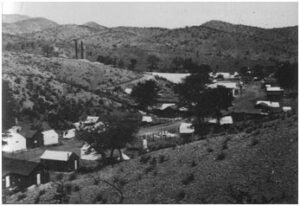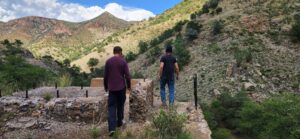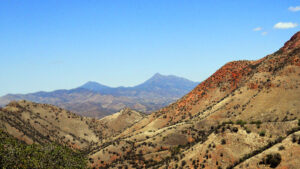The area where Patagonia is located provided Native-American communities with plentiful hunting and fishing opportunities. Archaeologists have identified the remains of Native American settlements, resource processing sites, and petroglyphs in the area surrounding Patagonia. The area was known as a Tohono O’odham ranchería, or seasonal village called Sonoitac.
In 1539, Spanish explorer Fray Marcos de Niza entered the area near Lochiel on the Mexican border. He continued on his journey to Zuni Pueblo, New Mexico, also known as the Seven Cities of Cibola. Marcos de Niza is credited with being the first European in what is now the State of Arizona. The main Native American tribes in the area at that time were the Sobaipuri and Papago (Tohono O’odham).
The mission period ended in 1768 by a decree of Charles III of Spain. In 1821, the Mexican War of Independence between Mexico and Spain came to an end, and the territory of New Spain, which included Arizona, was ceded to Mexico.`
By the mid-1850s, prospectors were mining the silver-rich mountains east of Sonoita. By the 1860s, vast amounts of silver and lead were retrieved from the Patagonia Mountains each year. In 1854, the United States purchased the region from Mexico in what is known as the Gadsden Purchase. Americans of European descent from the East Coast of the United States began to arrive in the area. They were protected from the constant attacks of the Apaches by the United States Military. However, The majority of the troops were withdrawn from the area upon the outbreak of the American Civil War. Fort Buchanan, a small garrison established in 1856 near Sonoita, was overrun by the Apaches. Thus, the miners, ranchers, and farmers in the region were without protection from the Apaches, and many of them moved to other areas.
In 1867, with the war done, the army was sent back into the area, creating Camp Crittendon, and mining and ranching activity picked up once again. By 1900, Patagonia rated a two-story railroad depot and by WWI, Patagonia had running water, an Opera House, three hotels, a schoolhouse, two parks, and several stores and saloons.
The 1920s were a period of uncertainty, and the stock market crash in 1929 was one of three town misfortunes that year. The economy didn’t improve until the late 1930s when ASARCO built a mill and power plant at the Flux and Trench mines in the area. Those and other mines were revived to supply lead, copper, zinc, and molybdenum to the allied armies of World War II.
Today, The Hermosa project is being developed by Arizona Mining, a subsidiary of South32, a diversified mining company headquartered in Australia. The project is just outside of town and consists of two major deposits, the Taylor and Clark deposits.
The Taylor deposit is a polymetallic deposit that contains zinc, lead, copper, and silver. The Clark deposit is a silver-manganese deposit. The project is being developed as an underground mine and is expected to produce zinc, lead, copper, and silver concentrates.
The Hermosa project has undergone an extensive environmental review process and has received several permits from state and federal agencies.
In 1947, townspeople called for incorporation, which became official on February 10, 1948. In 1957 troubles came again as ASARCO closed the Mill and Power Plant. In a month, the railroad had abandoned the depot and was pulling up the tracks. Suddenly the town’s main sources of income were gone.
Since then, the Town has made slow but steady progress, capitalizing on the area’s scenic beauty and unique ecology as an area with perhaps the greatest diversity of plant and animal species to be found in the US, together with its favorable climate and a growing colony of artisans and artists. Birders, fishermen, and hikers share the streets with shoppers looking for that perfect, unique gift, and everyone revels in the delightful weather.
In the late 19th century, Patagonia was a hub of mining activity. The area was rich in minerals, including silver, lead, and zinc, and many mines were established to extract these valuable resources. At the time, mining was one of the most important industries in the West, and Patagonia was no exception. The town was home to many miners and their families, and mining-related businesses flourished.
 One of the most famous mines in Patagonia was the Greaterville Mine. This lead and silver mine was established in the 1880s and quickly became one of the largest in the region. The Greaterville Mine was renowned for its high-quality ore and was one of the largest employers in Patagonia for many years. Other notable mines in the area included the Palmetto Mine and the Blue Bird Mine.
One of the most famous mines in Patagonia was the Greaterville Mine. This lead and silver mine was established in the 1880s and quickly became one of the largest in the region. The Greaterville Mine was renowned for its high-quality ore and was one of the largest employers in Patagonia for many years. Other notable mines in the area included the Palmetto Mine and the Blue Bird Mine.
As the copper mines began to deplete in the early 1900s, the population of Harshaw started to decline. The town’s post office closed in 1924, and by the 1930s, most of the buildings had been abandoned. Today, Harshaw is a ghost town, with only a few ruins remaining to remind visitors of its rich mining history.
The town is now primarily a popular tourist destination, attracting visitors interested in exploring the ruins and learning about the area’s rich mining history.
 The World’s Fair Mine (Arizona Daily Star article 2013) – was discovered in the 1880s and quickly became a major source of copper and other minerals. Over the years, the mine was expanded and modernized, and it eventually became one of the largest and most productive mines in Southern Arizona.
The World’s Fair Mine (Arizona Daily Star article 2013) – was discovered in the 1880s and quickly became a major source of copper and other minerals. Over the years, the mine was expanded and modernized, and it eventually became one of the largest and most productive mines in Southern Arizona.
The World’s Fair Mine likely got its name because it was operational during the time of the World’s Fair of 1893 in Chicago. The World’s Fair was a large international exhibition showcasing advancements in industry, culture, and technology. It’s possible that the mine owners wanted to capitalize on the excitement and attention surrounding the World’s Fair by naming their mine after it. The exact reason for the naming of the mine is not known, but this is a possible explanation.
Despite its success, the World’s Fair Mine faced numerous challenges throughout its history. For example, it was forced to shut down temporarily several times due to economic downturns and fluctuations in the price of copper. Nevertheless, the mine was eventually able to overcome these difficulties and continue operating until the late 1920s.
Today, the World’s Fair Mine is a popular tourist attraction located by a steep hike, horseback or ATV/4×4 from our ranch. The site is a beautiful experience to explore the remains of this historic mining site and learn about the region’s rich mining history. The mine also serves as an important reminder of the hard work and determination of the miners who once worked there and of the role that mining played in shaping the economic and cultural landscape of Southern Arizona.
Patagonia is home to the Patagonia Museum, which showcases the history of the town and the surrounding area, including its mining heritage. The museum is housed in the historic Grand Hotel, which was built in 1883 and is one of the oldest buildings in Patagonia. Visitors to the museum can learn about the town’s history and see artifacts from the mining era, including mining tools and equipment.
Today, Patagonia is a vibrant and thriving community that continues to honor its mining heritage. The town has a rich cultural heritage, with a thriving arts scene, and is surrounded by stunning natural beauty, including the nearby Coronado National Forest. Whether you’re a history buff, an outdoor enthusiast, or just looking for a peaceful and picturesque place to call home, Patagonia, Arizona, is the perfect place to be.
South32 is a mining company that has proposed a copper mine in Patagonia, Santa Cruz County, Arizona. The proposed mine, known as the Hermosa Project, would be located about 15 miles southeast of Patagonia and would be operated by South32 subsidiary Arizona Mining Inc.
The Hermosa Project is a large-scale mining operation that would extract copper, zinc, and other minerals from the ground. The project includes two open-pit mines, an underground mine, and a processing facility. The company estimates that the mine could produce up to 75,000 tons of copper concentrate per year over a 20-year lifespan.
The proposed mine has generated controversy in the area, with some residents and environmental groups expressing concerns about the potential impacts on the local environment and public health. Concerns include the potential for water contamination, air pollution, and habitat destruction. Some residents have also expressed concerns about the impact of the mine on local property values and the quality of life in the area.
South32 has stated that it is committed to responsible mining practices and has taken steps to address the concerns of local residents and environmental groups. The company has conducted extensive environmental and cultural studies, as well as engaging in public outreach and consultation with local stakeholders. In 2021, South32 received a key permit from the Arizona Department of Environmental Quality, which allows the company to move forward with the mine’s construction.
The Patagonia Area Resource Alliance (PARA), also known as the Patagonia Alliance, is a non-profit organization that works to protect the natural environment and rural communities of the Patagonia area in southeastern Arizona. The organization focuses on issues such as water quality, wildlife habitat, public lands, and sustainable economic development.
One of the primary issues that the Patagonia Alliance has been involved in is the proposed Hermosa Mine, a large-scale copper mine being developed by South32, a multinational mining company. The proposed mine site is located just southeast of Patagonia, near the town of Elgin, and is expected to impact the surrounding area’s environment and water resources.
The Patagonia Alliance has raised concerns about the potential negative impacts of the mine, including the destruction of critical wildlife habitat, contamination of water resources, and the negative impact on the local economy, including tourism and agriculture. The organization has also expressed concerns about the lack of transparency and public input during the permitting process for the mine.
In response to the proposed mine, the Patagonia Alliance has advocated for greater transparency and public input in the permitting process, as well as the need for a thorough environmental impact assessment that considers the full range of potential impacts. The organization has also advocated for the development of sustainable economic alternatives that do not rely on large-scale mining operations.
Overall, the Patagonia Alliance is committed to protecting the unique environment and rural communities of the Patagonia area and works to promote sustainable economic development and responsible resource management.